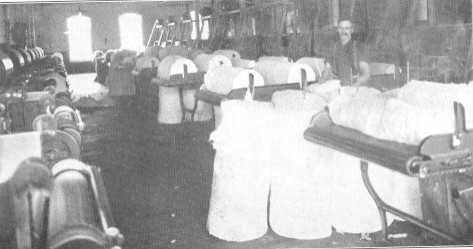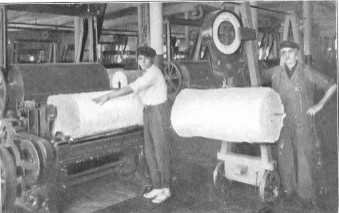Disclaimer
The Dover Public Library website offers public access to a wide range of information, including historical materials that are products of their particular times, and may contain values, language or stereotypes that would now be deemed insensitive, inappropriate or factually inaccurate. However, these records reflect the shared attitudes and values of the community from which they were collected and thus constitute an important social record.
The materials contained in the collection do not represent the opinions of the City of Dover, or the Dover Public Library.
The Cloth Manufacturing Process--2. Pickers
An Interview with John Howarth, Overseer of Carding No. 2 and 3 Mill.
Cocheco Chats, September 1921
In a previous issue we described the manner in which the cotton was opened up into a fluffy mass by the openers. Although some of the sand and seed is removed by these machines, the chief object is to take the cotton out of its matted state and put it in proper condition to be manufactured.
The next process, picking, is designed to remove all heavier dirt, seed, stalk, etc., from the cotton. This is effected by bringing a thin sheet of cotton into contact with a rapidly revolving beater, the blades of which strike the cotton a sharp blow. This causes the seed and the heavier impurities to be thrown through the space between the grids and out of the machine while the cotton is carried forward. The cotton usually goes through this process three times, passing through the breaker picker, intermediate picker, and finisher picker.
BREAKER PICKER
The cotton from the opener is conveyed by an air current through a large pipe to the hopper of the breaker picker, where it is fed in the form of a loose mass. It is carried forward to the feed rolls where it comes under the action of the beater. The beater removes much of the leaf, sand and dirt as previously explained. At the front of this machine, the cotton comes out in a sheet forty inches wide and is rolled into a “lap” very much in the way a roll of wrapping paper is put up.
INTERMEDIATE PICKER
The intermediate picker resembles very closely the breaker picker except that the cotton, instead of being fed loose into a hopper is taken in the form of a roll or “lap” from the breaker picker and placed upon the feed apron of the intermediate. Four laps are fed at a time on this apron thus securing four doublings, or the mixture of four laps. Such doublings insure that the stock is taken from several lots and helps to make the raw stock of even character as it runs through the mill.
These four laps unwind and run through the feed rolls to the beater where more of the leaf, seed, and dirt is taken out, and the cotton is wound into a lap at the front of the machine.
FINISHER PICKER
The finisher picker is another machine similar to the intermediate picker. Four of the laps from the intermediate picker are put on the apron at the back. The cotton again runs through the feed rolls to the beater, where, for the third time, foreign matter is taken out and the cleaned cotton is wound into a lap.

James Bentley feeding Finisher Picker
The lap from the finisher picker resembles cotton batting in general appearance. As it is taken from the machine, each lap is weighed. This weighing of the laps is important, for if it is too heavy, the yarn and the cloth that is made from it will be too heavy, or if the lap is light, the yarn or cloth will be too light. So those laps that are heavy and those that are light are carried to the back of the machine and reworked. It is necessary to avoid either extreme for if the work is too heavy or too light, it will run badly in the roving frames, spinning frames and looms; furthermore the cloth, being of the wrong weight, would be of inferior quality.

James Parker, Picker Foreman, Weighing a Finished Lap. John Williams, Doffing
This historical essay is provided free to all readers as an educational service. It may not be reproduced on any website, list, bulletin board, or in print without the permission of the Dover Public Library. Links to the Dover Public Library homepage or a specific article's URL are permissible.
